Akkerman
The city’s poshest pen shop, with an excellent selection of pens and writing accessories.
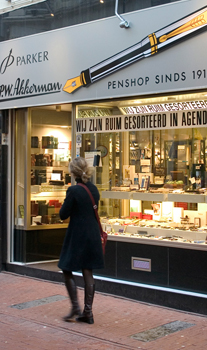
Amsterdam’s most vivacious district, the Old Centre is a tangle of antique streets and narrow canals, confined in the north by the River IJ and to the west and south by the Singel. Given the dominance of Centraal Station on most transport routes, this is where you’ll almost certainly arrive. From here a stroll across the bridge will take you onto the Damrak, which divided the Oude Zijde (Old Side) of the medieval city to the east from the smaller Nieuwe Zijde (New Side) to the west. It also leads to the heart of the Old Centre, Dam Square, the site of the city’s most imperious building, the Royal Palace (Koninklijk Paleis). Nowadays much of the Oude Zijde is taken up by the city’s notorious Red Light District – but the area is about more than just sleaze: its main canals and the houses that line them are among Amsterdam’s most handsome. And the Old Centre as a whole hosts some of the city’s best bars and restaurants alongside the tourist tat.

With its high gables and cheerful brickwork, Centraal Station is an imposing prelude to the city. Built in the 1880s, it aroused much controversy because it effectively separated the centre from the River IJ, source of the city’s wealth, for the first time in Amsterdam’s long history. Inside, the cavernous main booking hall and grand arches have a suitable sense of occasion, and from here the whole of Amsterdam lies before you. However, for the moment, Stationsplein just outside is a pretty unprepossessing introduction to the city: a messy open space, edged by ovals of water and cut through by trams. It’s currently dominated by the building works of the city’s new north-south transport link, which are taking a lot longer than expected. Once they’re complete, expect a much spruced-up open space (see Got the builders in?).

The station area and inner harbour have frankly looked a bit of a mess for as long as most people can remember, due to a long-running project to redevelop the station and the surrounding area at the same time while building a new metro line to link the city centre with the south of the city and the resurgent north across the IJ. City centre stations are to be built at Centraal Station, Rokin and the Vijzelgracht, and for the best part of six years now the area around Stationsplein has been a massive construction site – and the chaos looks set to continue for some time, at least until the completion of the project in 2015. There has been huge controversy over the plan: some question whether it’s even possible to build a tunnel under a city centre that is mainly built on wooden stilts, and work was halted for a while a couple of years back when a number of buildings began to collapse. But the authorities are determined to press on, and claim they will not only deliver better connections between the city centre and outlying districts, but also a pedestrian-friendly Stationsplein and inner harbour. Whatever the result, it will seem like an improvement after the last couple of years.
Dating back to the 1880s, the city’s foremost Catholic church, with its whopping twin towers and spacious interior is dedicated to the patron saint of sailors – and of Amsterdam. Above the altar is the crown of the Habsburg Emperor Maximilian, very much a symbol of the city.
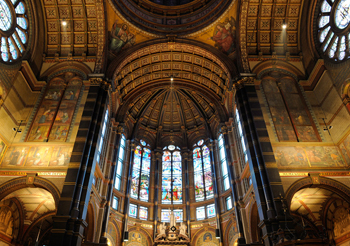
Running from Centraal Station to Dam Square, Damrak was a canal and the city’s main nautical artery until 1672, when it was filled in – much to the relief of the locals, who were tired of the stink. With the docks moved elsewhere, Damrak became a busy commercial drag, as it remains today: an unenticing avenue lined with tacky restaurants, bars and bureaux de change.
The area immediately to the east of Damrak is the Red Light District, known locally as “De Walletjes” (Small Walls) on account of the series of low brick walls that contains its canals. The district stretches across the two narrow canals that once marked the eastern part of medieval Amsterdam – Oudezijds Voorburgwal and Oudezijds Achterburgwal – with the far canal of Kloveniersburgwal forming its eastern boundary. Despite auspicious beginnings as the aptly named “Velvet Canal” – look out for the handsome facades of Oudezijds Voorburgwal that recall ritzier days – nowadays the area is full of the “window brothels”, sex shops and porn cinemas and theatres that have long been one of the city’s most distinctive draws, the girls in particular drawing crowd of goggling tourists and potential customers in equal measure.
There’s an undertow to the district, however, that isn’t particularly pleasant. Many of the girls are illegal immigrants, who hand over a fair percentage of their earnings to their pimps, and the city has taken action over recent years to crack down on the number of women working here, buying up some of the buildings and encouraging other sorts of business to flourish – you’ll notice the odd window with a design or fashion display. But there’s no doubt that for the moment at least, sex is still the main event here. The Prostitution Information Centre at Enge Kerksteeg 3, runs Red Light District tours (Sat 5pm €12.50) if you want to know more, while on a more frivolous note you may want to check out the Erotic Museum Oudezijds Achterburgwal 54 (daily 11am–1am €7), or the slightly better value Sex Museum five minutes’ walk away at Damrak 18 (daily 9.30am–11.30pm €4) – both of which have several floors of porn and erotica through the ages to entertain you. One word of warning: don’t even think about taking a picture of one of the windows, unless you’re prepared for some major grief from the camera-shy prostitutes or their minders.

The imposing bulk of the Beurs – the old Stock Exchange – is a seminal work designed at the turn of the twentieth century by the leading light of the Dutch modern movement, Hendrik Petrus Berlage. Berlage re-routed Dutch architecture with this building, forsaking the classicism that had dominated the nineteenth century for a modern style with cleaner lines. The Beurs has long since lost its commercial function and today it’s used for exhibitions, concerts and conferences, which means that sometimes you can go in, sometimes you can’t. Inside, the main hall is distinguished by the graceful lines of its exposed ironwork and its shallow-arched arcades as well as the fanciful frieze celebrating the stockbroker’s trade. If it’s closed, stop by the café that fronts onto Beursplein around the corner (see Cafés and Tearooms) for a coffee and admire the tiled scenes of the past, present and the future by Jan Toorop.
It was Dam Square that gave Amsterdam its name: in the thirteenth century the River Amstel was dammed here, and the fishing village that grew around it became known as “Amstelredam”. Boats could sail into the square down the Damrak and unload right in the middle of the settlement, which soon prospered by trading herrings for Baltic grain. Today it’s an open and airy but somehow rather desultory square, despite the presence of the main municipal war memorial, a prominent stone tusk adorned by bleak, suffering figures and decorated with the coats of arms of each of the Netherlands’ provinces (plus the ex-colony of Indonesia). The Amsterdam branch of Madame Tussaud’s waxworks is here, at no. 20 (daily: Jan–March & Nov–Dec 10am–5.30pm; April–June & Sept–Oct 10am–6.30pm; July 10am–8.30pm; Aug 10am–9.30pm last entry 1hr before closing €21, children 5–15 €16 www.madametussauds.nl).
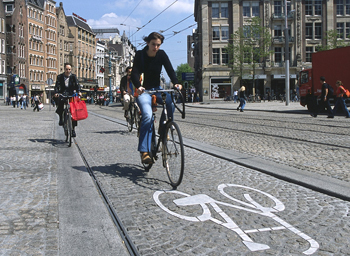
Dominating Dam Square is the Royal Palace – Koninklijk Paleis – though the title is deceptive, given that this vast structure started out as the city’s town hall and only had its first royal occupant when Louis Bonaparte, brother of Napoleon, moved in during the French occupation.
At the time of the building’s construction in the mid-seventeenth century, Amsterdam was at the height of its powers, and the city council craved a residence that was a suitable declaration of its wealth and independence. They opted for a progressive design by Jacob van Campen, and in 1648 work started on what was then the largest town hall in Europe. The exterior is full of symbolism, with a couple of depictions of Amsterdam as a port and trading centre – the tableau at the front is presided over by Neptune and a veritable herd of unicorns. The interior, too, proclaims the pride and confidence of the time, in particular the lavish Citizen’s Hall, a handsome marble chamber situated at the heart of the building. Here the enthroned figure of Amsterdam sits over the entrance, flanked by figures representing Strength and Wisdom; at the opposite end, the figure of Justice perches over the entrance to the Magistrates’ Chamber, below another giant figure of Atlas.
Start your tour here and follow the rooms around, taking in the witty symbolism that pervades the building: cocks fight above the entrance to the Commissioner of Petty Affairs, while Apollo, god of the sun and the arts, brings harmony to the disputes; outside the Bankruptcy Chamber a relief shows the Fall of Icarus, above which marble carvings depicting hungry rats scurrying around an empty chest and unpaid bills; and two large paintings in the Burgomaster’s Cabinet, one by Ferdinand Bol the other by Govert Flinck, show how the burgomasters fancied themselves above corruption in the manner of Roman Consuls. The Burgomasters’ Chamber, next door, looks down on the ground-floor Tribunal, where they gave advice to the judges sitting on the marble benches as they passed judgement on hapless criminals.

Vying for importance with the Royal Palace is the adjacent Nieuwe Kerk, which despite its name – “new church” – is an early fifteenth-century structure built in a late flourish of the Gothic style, with a forest of pinnacles and high, slender gables. Nowadays it’s de-sanctified and used for temporary exhibitions. Opening times vary according to what’s on, and occasionally it’s closed altogether when changing exhibitions. But it is worth going in if you can: its hangar-like interior holds a scattering of decorative highlights, such as the seventeenth-century tomb of Dutch naval hero Admiral Michiel de Ruyter, complete with trumpeting angels, conch-blowing Neptunes and cherubs all in a tizzy.
Nieuwezijds Voorburgwal
Mon 11am–7pm, Tues–Sat 10am–7pm, Thurs until 9pm, Sun noon–7pm
Behind the Royal Palace, you can’t miss the old neo-Gothic post office of 1899, now converted into the Magna Plaza shopping mall, housing numerous clothes chains.
The Oude Kerk is the city’s most appealing church. There’s been a church on this site since the middle of the thirteenth century, but most of the present building dates from a century later, funded by the pilgrims who came here in their hundreds following a widely publicized miracle. The story goes that in 1345 a dying man regurgitated the Host he had received here at Communion and when it was thrown on the fire afterwards, it did not burn. The unburnable Host was placed in a chest and eventually installed here, and although it disappeared during the Reformation, thousands of the faithful still come to take part in the annual commemorative Stille Omgang in mid-March, a silent nocturnal procession terminating at the Oude Kerk. Inside you can see the unadorned memorial tablet of Rembrandt’s first wife, Saskia van Uylenburg, beneath the smaller of the organs, and three beautifully coloured stained-glass windows beside the ambulatory dating from the 1550s. Oude Kerk’s tower is open weekends (April–Sept 1–4.30pm €6).

A few metres north of the Oude Kerk is the lovely Amstelkring, a former Catholic church, now one of Amsterdam’s most enjoyable museums. The Amstelkring – “Amstel Circle” – is named after the group of nineteenth-century historians who saved the building from demolition, but its proper name is Ons Lieve Heer Op Solder (“Our Dear Lord in the Attic”). The church dates from the early seventeenth century when, with the Protestants firmly in control, the city’s Catholics were only allowed to practise their faith in private – as here in this clandestine church, which occupies the loft of a wealthy merchant’s house. The church’s narrow nave has been skilfully shoehorned into the available space and, flanked by elegant balconies, there’s just enough room for an ornately carved organ at one end and a mock-marble high altar, decorated with Jacob de Wit’s mawkish Baptism of Christ, at the other. The rest of the house is similarly untouched, its original furnishings reminiscent of interiors by Vermeer or De Hooch.

The Hash Marihuana Hemp Museum features displays on different kinds of dope and the huge number of ways to imbibe and otherwise use it, both here and in the associated Hemp Gallery a few doors down. There’s also an indoor marijuana garden, samples of textiles and paper made with hemp, and pamphlets explaining the medicinal properties of cannabis, and, of course, a shop selling pipes, books, videos and plenty of souvenirs.
On the far side of the Red Light District is the Nieuwmarkt, a wide open cobbled square that was long one of the city’s most important markets. Its main focus is the multi-turreted Waag, a delightful building dating from the 1480s, when it served as one of the city’s fortified gates, the Sint Antoniespoort, before being turned into a municipal weighing-house (waag), with the rooms upstairs taken over by the surgeons’ guild. It was here that the surgeons held lectures on anatomy and public dissections, the inspiration for Rembrandt’s famous Anatomy Lesson of Dr Tulp. It has now been converted into a café-bar and restaurant, In de Waag.
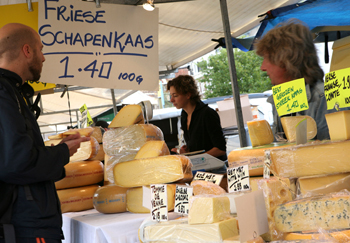
Geldersekade
A few minutes’ walk north from Nieuwmarkt, the squat Schreierstoren (Weepers’ Tower) is a rare surviving chunk of the city’s medieval wall. Originally, the tower overlooked the River IJ and it was here (legend has it) that women gathered to watch their menfolk sail away – hence its name. A badly weathered stone plaque inserted in the wall is a reminder of all those sad goodbyes, and another much more recent plaque recalls the departure of Henry Hudson from here in 1609, when he stumbled across an island the locals called Manhattan.
Prins Hendrikkade 108
Now occupied by the five-star Amrath hotel, this is one of the city’s most flamboyant Art Deco buildings, covered with a welter of marine connections – the entrance is shaped like the prow of a ship, and surmounted by statues of Poseidon and his wife, and representations of the four points of the compass.
Nieuwmarkt lies at the northern end of Kloveniersburgwal, a long, dead-straight waterway framed by old, dignified facades. One house of special note is the Trippenhuis, at no. 29, a huge overblown mansion complete with Corinthian pilasters and a grand frieze built for the Trip family in 1662. One of the richest families in Amsterdam, the Trips were one of a clique of families (Six, Trip, Hooft and Pauw) who shared power during the city’s Golden Age.
Almost directly opposite, on the west bank of the canal, the Kleine Trippenhuis at no. 26 is, by contrast, one of the narrowest houses in Amsterdam, complete with a warmly carved facade with a balustrade featuring centaurs and sphinxes. Legend asserts that Mr Trip’s coachman was so taken aback by the size of the new family mansion that he exclaimed he would be happy with a home no wider than the Trips’ front door – which is exactly what he got.
Stretching south from the wide open spaces of the Nieuwmarkt, St Antoniesbreestraat once linked the city centre with the Jewish quarter, but its huddle of shops and houses was mostly demolished in the 1980s to make way for a main road. The plan was subsequently abandoned, but the modern buildings that now line most of the street hardly fire the soul, even if the modern symmetries – and cubist, coloured panels – of the apartment blocks that spill along part of the street are visually arresting.
One of the few survivors of all this development is the Pintohuis, which is now a public library. Easily spotted by its off-white Italianate facade, the mansion is named after Isaac de Pinto, a Jew who fled Portugal to escape the Inquisition and subsequently became a founder of the East India Company. Pinto bought the property in 1651 and promptly had it remodelled in grand style, the facade interrupted by six lofty pilasters, which lead the eye up to the blind balustrade. The mansion was the talk of the town, even more so when Pinto had the interior painted in a similar style to the front – pop in to look at the birds and cherubs of the original painted ceiling.
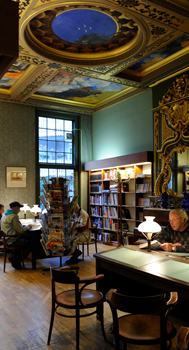
The Zuiderkerk dates from 1611 and was designed by the prolific architect and sculptor Hendrick de Keyser, whose distinctive – and very popular – style extrapolated elements of traditional Flemish design, with fanciful detail and frilly towers added wherever possible. The soaring tower is typical of his work and comes complete with balconies and balustrades, arches and columns. Now deconsecrated, the church has been turned into a municipal information centre with displays on housing and the environment, plus temporary exhibitions revealing the city council’s future plans. The tower, which has a separate entrance, can be climbed during the summer (April–Sept Wed–Sat 2–4pm €6).

At the top of Kloveniersburgwal, on the right, the Oudemanhuispoort is a covered passageway leading off the street, and is lined with secondhand bookstalls (Mon–Sat 10am–4pm); it was formerly part of an almshouse complex for elderly men – hence the unusual name. The buildings on either side are part of the University of Amsterdam, which dominates this part of town. You can either wander through its peaceful precincts or, just beyond, cross the south end of Kloveniersburgwal to one of the prettiest corners of the city – a small pocket of placid waterways and old canal houses that extends east to Groenburgwal, a delightful, dead-end canal.
The Rokin picks up where the Damrak leaves off, cutting south from Dam Square in a wide sweep that follows the former course of the River Amstel. This was the business centre of the nineteenth-century city, and although it has lost much of its prestige it is still flanked by an attractive medley of architectural styles incorporating everything from grandiose nineteenth-century mansions to more utilitarian modern stuff. Running parallel, pedestrianized Kalverstraat is a busy shopping street that has been a commercial centre since medieval times, when it was used as a calf market; nowadays it’s home to many of the city’s chain stores and clothes shops – you could be anywhere in Holland really.
Oude Turfmarkt 127
![]() 020/525 2556
020/525 2556
Tues–Fri 10am–5pm, Sat & Sun 1–5pm
€6.50
A good old-fashioned archeological museum in a solid Neoclassical building dating from the 1860s, the Allard Pierson Museum holds a wide-ranging but fairly small collection of finds retrieved from Egypt, Greece and Italy. The particular highlights are the museum’s Greek pottery, with fine examples of both the black- and red-figured wares produced in the sixth and fifth centuries BC, and several ornate Roman sarcophagi.
Nieuwe Doelenstraat 24
Just off Muntplein, the Hotel Doelen incorporates the Kloveniers Tower, and was once the headquarters and meeting place of the company Rembrandt depicted in his painting The Night Watch. No one knows for sure whether he painted the famous work here, but it certainly hung in the building for a time, and if you ask nicely in reception they will let you stroll up to see where it was, although there’s not much to look at beyond crumbling redbrick wall and a bad photo of the painting.
Across Kalverstraat, Heiligeweg, or “Holy Way”, was once part of a much longer route used by pilgrims heading into Amsterdam. Every other religious reference disappeared centuries ago, but there is one interesting edifice here, the fanciful gateway of the old Rasphuis (House of Correction) that now fronts a shopping mall at the foot of Voetboogstraat. The gateway is surmounted by a sculpture of a woman punishing two criminals chained at her sides above the single word “Castigatio” (punishment). Beneath is a carving by Hendrik de Keyser showing wolves and lions cringing before the whip.
Cut up Voetboogstraat and you soon reach the Spui, whose west end opens out into a wide, tram-clanking intersection in the middle of which is a cloying statue of a young boy, known as ’t Lieverdje (“Little Darling” or “Loveable Scamp”), a gift to the city from a cigarette company in 1960. It was here in the mid-1960s, with the statue seen as a symbol of the addicted consumer, that the playful political mavericks, the Provos, organized some of their most successful public pranks. There’s a small secondhand book market here on Friday mornings.
A little gateway on the north side of the Spui leads into the Begijnhof, where a huddle of immaculately maintained old houses looks onto a central green; if this door is locked, try the main entrance, just a couple of hundred metres north of the Spui on Gedempte Begijnensloot. The Begijnhof was founded in the fourteenth century as a home for the beguines – members of a Catholic sisterhood living as nuns, but without vows and with the right of return to the secular world. The original medieval complex comprised a series of humble brick cottages, but these were mostly replaced by the larger, grander houses of today shortly after the Reformation, though the secretive, enclosed design survived.
The Engelse Kerk which takes up one side of the Begijnhof is of medieval construction, but it was taken from the beguines and given to Amsterdam’s English community during the Reformation and is of interest for the carefully worked panels on the pulpit, which were designed by a youthful Piet Mondriaan.The beguines, meanwhile, celebrated Mass inconspicuously in the clandestine Catholic Begijnhof Kapel, which they established in the house opposite their old church, and this is still used today, a homely and very devout place, full of paintings and with large balconies on either side of the main nave.

Two entrances: Nieuwezijds Voorburgwal 357 & Kalverstraat 92
![]() 020/523 1822
020/523 1822
Mon–Fri 10am–5pm, Sat & Sun 11am–5pm
€10
Just metres from the Begijnhof, the Schuttersgalerij – the Civic Guard Gallery (free) – also accessible from Kalverstraat and St Luciensteeg, is lined by an interesting assortment of group portraits of the Amsterdam militia, painted when the city was at the height of its economic success. The gallery is actually part of the adjoining Amsterdams Historisch Museum, which occupies the smartly restored but rambling seventeenth-century buildings of the municipal orphanage. This museum surveys the city’s development with a scattering of artefacts and lots of paintings from the thirteenth century onwards – a somewhat garbled collection, but at least the labelling is mostly in English as well as Dutch.
Maps and paintings punctuate the galleries and record the growth of the city, starting with an electronic map showing the city’s evolution form the draining of the Amstel in 1274 to the present day. Cornelis Anthonisz’s 1538 Bird’s Eye View of Amsterdam is the oldest surviving plan of the city, and in the next room there are various renderings of the old and new town halls, the latter now the Royal Palace.
High points beyond here include a number of paintings from the city’s Golden Age – Rembrandt’s wonderful Anatomy Lesson of Dr Jan Deijman stands out – and others depicting the regents of several orphanages, smug and content in the company of the grateful poor. But the museum doesn’t only focus on the Golden Age, and has objects of interest right up to the modern era, starting with Breitner’s depictions of Dam Square from 1898, through the war years and Nazi occupation, to postwar material that includes the Cobra painter Karel Appel’s murals for the town hall (now decorating the city’s Grand Hotel restaurant) and the liberalization of dope and growth of the city’s coffeeshops.
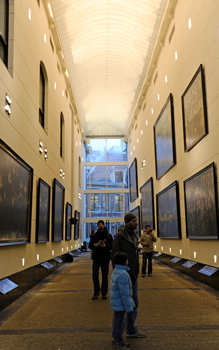
The city’s poshest pen shop, with an excellent selection of pens and writing accessories.

A great stock of books in English, and one of the city’s best sources of English-language magazines and newspapers.
The “Beer King” is aptly named: 950 different beers, with the appropriate glasses to drink them from – just in case you thought beer-drinking could be taken lightly.
The city’s top department store, very slick and good for clothes, accessories and kids’ stuff.
Perhaps the world’s most famous condom shop, selling condoms of every shape, size and flavour imaginable.
The Amsterdam HQ of the Dutch design collective is a shrine to both simplicity and artsiness, with attention-grabbing furniture, clothes and household objects.
Oddly situated among Warmoesstraat’s loud bars and porn shops, this is one of the city’s oldest and best-equipped coffee and tea specialists, and has a small museum of coffee upstairs.
In business at this address since 1778, this is a traditional homeopathic chemist with any amount of herbs and natural cosmetics, as well as a huge stock of drop (Dutch liquorice).
Main Amsterdam branch of this cool Dutch womenswear brand: great clothes, and a nice environment for browsing.
Established tobacconist selling its own and other brands of cigars, tobacco, smoking accessories, and every make of cigarette you can think of.
Posh stationery, cards and, best of all, a choice of hundreds of rubber stamps.
Perhaps the best chocolate shop in town – all handmade, with an array of fantastic and imaginative fillings.
The largest gay and lesbian bookshop in Europe, with books, magazines and videos.
Quirky coffeeshop with spiral staircases that are challenging after a spliff. The hot chocolate with hash is not for the susceptible.

Colourful coffeeshop with a laidback atmosphere that is known for its range of good-quality weed and hash.
Cosy, graffitied coffeeshop full of comfy chairs and handily situated next door to a police station – hence the name. Also with a smaller sister branch at Nieuwmarkt 14.
Newly renovated, this is the biggest and best of this small chain of coffeeshops, with good deals and excellent hot chocolate. There’s a smaller branch at Langebrugsteeg 9, just off the Rokin.
One of the first Amsterdam coffeeshops, a cramped but vibrant place that’s a favourite with both dope fans and tea addicts (it has 40 different kinds).
The best chance to glimpse the interior of the Beurs, and an elegantly furnished place to drink coffee or eat lunch.
Great self-service restaurant that’s easily the best spot on Damrak to grab a quick spot of lunch – from sandwiches and burgers to sushi and stir-fries – and a nice environment too, with a small terrace that gives good views of the Oude Kerk tower on fine days (see De Bijenkorf under Shops).
Tiny place off one of the grungier stretches of Kalverstraat. Nice breakfasts, an array of inventive sandwiches for lunch, and then – their speciality – high tea served in the afternoon.
A hidden treasure in an eighteenth-century courtyard, it sells Indonesian coffee and countless different tea blends.
One of the grandest of the grand cafés, overlooking the Amstel next to the university, with three floors and two terraces. A great place to nurse the Sunday papers. It serves reasonably priced food too, and there’s a great salad bar.
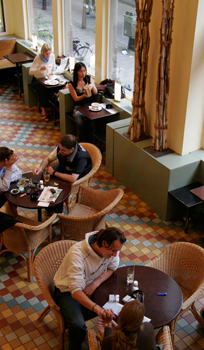
Homely shop and café that sells bric-a-brac as well as serving good coffee and decent lunches.
Lovely café that serves delicious salads, sandwiches and pastries, a few doors down from its sister chocolate shop.

This eetcafé serves a satisfying mixture of Dutch staples and modern European fare in relaxed surroundings.
Hole-in-the-wall takeaway with a long-established reputation for serving the best frites in town.
This Thai canteen is always packed, and rightly so, for its cheap and authentic Thai fare. Its big brother across the road serves much the same food in slightly more upscale surroundings.
Quite a haven, situated down an alley in the heart of the Red Light District, with tremendous French-Dutch food and a wonderfully soothing environment after the mayhem of the streets outside.
Casual and inexpensive brown café run by a native of Switzerland and patronized by a predominantly arty clientele. Its speciality is, not surprisingly, excellent cheese fondue.
A really busy spot at lunchtime, when it does a stripped-down menu of big sandwiches, salads, soup and a couple of pasta dishes. More upmarket after dark, when its refined and complex regional Italian menu takes over.
Tasty meat, fish and vegetarian food in French-Italian style at reasonable prices in an informal atmosphere. The name “heavenly mud” refers to the dark and white chocolate dessert with vanilla cream.
This big, light room has been serving hearty Dutch food to cheapskates for years and continues – justifiably – to thrive. Its three-course €7.50 menu is one of the city’s best bargains.
Classic Italian food with some inventive twists, incorporating good homemade pasta dishes and excellent service in an unpretentious and modern environment.
Arguably the best of a number of cheap Chinese diners along this stretch.
Small Indonesian café-restaurant whose great value-for-money menu is far from extensive but comprises well-prepared, simple dishes such as gado gado, sateh and rendang.
It looks like a bar but is more of a restaurant these days, serving steaks, fish and so on from an ever-changing menu that isn’t written down but is heroically memorized by the attentive waiting staff. Good food, and cheap too – mains from €12.
Very popular and ultra-lively bar of the Italian restaurant downstairs, which goes on noisily into the small hours. The restaurant is open until 11pm.
Don’t waste your time in the unappealing drinkeries of the Red Light District proper; this place is a few steps away and offers home-brewed beer, a good bar menu and a very convivial atmosphere, just off the top end of Nieuwmarkt.
Tiny bar behind the Nieuwe Kerk that serves up Belgian brews along with sounds from a disc-spinning DJ.
Over 50 wines by the glass in this elegant wine and champagne bar. The knowledgeable staff will help you decide what to have in line with your tastes.
Dark, noisy late-night bar with pool, DJs and irregular live music.
Tasting house for spirits and liqueurs. Clients tend to be well heeled or well soused (often both).
Once the meeting place of Amsterdam’s bookish types, this is still known as a literary café. It’s relaxed and informal, with live jazz on Sunday afternoons.
Intimate bar with a superb selection of Belgian beers – and with the correct glasses to drink them from. The genial barman will help you choose.
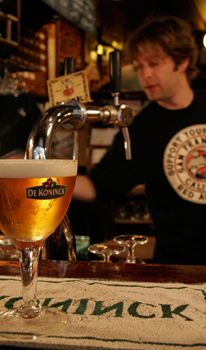
One of Amsterdam’s oldest and best-known bars, frequented by the city’s businessfolk on their way home. Summer is especially good, when the throngs spill out onto the street.
A bar since the days when Zeedijk was the haunt of sailors on the razzle, and still one the city centre’s best watering holes. Get a plate of cheese or sausage to help the ale go down.
Crowded, trendy grand café with a long and deep bar, a good selection of snacks, and possibly the best hamburgers in town.
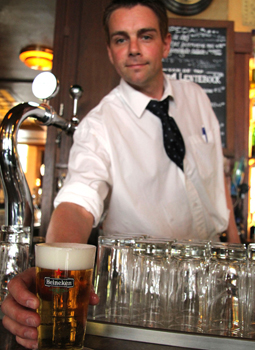
Cosy bar hidden just behind the Krasnapolsky hotel off Dam Square. It offers a vast range of its own flavoured jenevers that used to be distilled down the street.
Bar-cum-club with DJs every night and regular live music too.
What used to be the capital’s first lounge bar turned into a posh and stylish house club, frequented by the rich and famous.
Underground venue in the heart of the red light district, hosting everything from DJ nights to band competitions, movie screenings and themed parties.